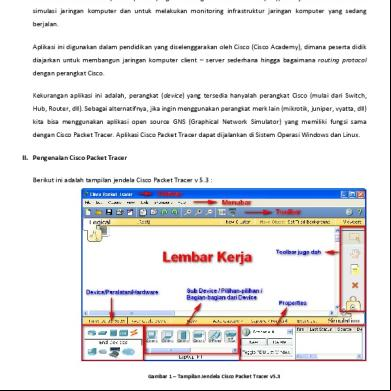8.2.2.7 Cisco Packet Tracer 721v42
This document was ed by and they confirmed that they have the permission to share it. If you are author or own the copyright of this book, please report to us by using this report form. Report 3b7i
Overview 3e4r5l
& View 8.2.2.7 Cisco Packet Tracer as PDF for free.
More details w3441
- Words: 424
- Pages: 3
8.2.2.7 Packet Tracer – Configuring OSPFv2 in a Single Area Addressing Table Device
Interface
IP Address
Subnet Mask
Default Gateway
G0/0
172.16.1.1
255.255.255.0
N/A
S0/0/0
172.16.3.1
255.255.255.252
N/A
S0/0/1
192.168.10.5
255.255.255.252
N/A
G0/0
172.16.2.1
255.255.255.0
N/A
S0/0/0
172.16.3.2
255.255.255.252
N/A
S0/0/1
192.168.10.9
255.255.255.252
N/A
G0/0
192.168.1.1
255.255.255.0
N/A
S0/0/0
192.168.10.6
255.255.255.252
N/A
S0/0/1
192.168.10.10
255.255.255.252
N/A
PC1
NIC
172.16.1.2
255.255.255.0
172.16.1.1
PC2
NIC
172.16.2.2
255.255.255.0
172.16.2.1
PC3
NIC
192.168.1.2
255.255.255.0
192.168.1.1
R1
R2
R3
Objectives Part 1: Configure OSPFv2 Routing Part 2: the Configurations
Background In this activity, the IP addressing is already configured. You are responsible for configuring the three router topology with basic single area OSPFv2 and then ing connectivity between end devices.
Part 1: Configure OSPFv2 Routing Step 1: Configure OSPF on the R1, R2 and R3. Use the following requirements to configure OSPF routing on all three routers: -
Process ID 10 Router ID for each router: R1 = 1.1.1.1; R2 = 2.2.2.2; R3 = 3.3.3.3 Network address for each interface LAN interface set to ive (do not use the default keyword)
Step 2: OSPF routing is operational. On each router, the routing table should now have a route to every network in the topology.
Part 2: the Configurations Each PC should be able to ping the other two PCs. If not, check your configurations.
R1>en R1#config t Enter configuration commands, one per line. End with CNTL/Z. R1(config)#router ospf 10 R1(config-router)#router-id 1.1.1.1 R1(config-router)#network 172.16.1.0 area 0 ^ % Invalid input detected at '^' marker. R1(config-router)#network 172.16.1.0 0.0.0.255 area 0 R1(config-router)#network 192.168.10.4 0.0.0.3 area 0 R1(config-router)#network 172.16.3.0 0.0.0.3 area 0 R1(config-router)#ive-int g0/0 R1(config-router)# 00:13:00: %OSPF-5-ADJCHG: Process 10, Nbr 2.2.2.2 on Serial0/0/0 from LOADING to FULL, Loading Done 00:15:07: %OSPF-5-ADJCHG: Process 10, Nbr 3.3.3.3 on Serial0/0/1 from LOADING to FULL, Loading Done R2>en R2#conf t Enter configuration commands, one per line. End with CNTL/Z. R2(config)#router ospf 10 R2(config-router)#router-id 2.2.2.2 R2(config-router)#network 172.16.2.0 0.0.0.255 area 0 R2(config-router)#network 172.16.3.0 0.0.0.3 area 0 R2(config-router)# 00:13:00: %OSPF-5-ADJCHG: Process 10, Nbr 1.1.1.1 on Serial0/0/0 from LOADING to FULL, Loading Done R2(config-router)#network 192.168.10.8 0.0.0.3 area 0 R2(config-router)#ive-int g0/0 R2(config-router)# 00:16:38: %OSPF-5-ADJCHG: Process 10, Nbr 3.3.3.3 on Serial0/0/1 from LOADING to FULL, Loading Done R3>en R3#conf t Enter configuration commands, one per line. End with CNTL/Z. R3(config)#router ospf 10 R3(config-router)#router-id 3.3.3.3 R3(config-router)#network 192.168.10.4 0.0.0.3 area 0 R3(config-router)#network
00:15:07: %OSPF-5-ADJCHG: Process 10, Nbr 1.1.1.1 on Serial0/0/0 from LOADING to FULL, Loading Done 192.168.1.0 0.0.0.3 area 0 R3(config-router)#network 192.168.10.8 0.0.0.3 area 0 R3(config-router)# 00:16:38: %OSPF-5-ADJCHG: Process 10, Nbr 2.2.2.2 on Serial0/0/1 from LOADING to FULL, Loading Done R3(config-router)#ive-int g0/0
Interface
IP Address
Subnet Mask
Default Gateway
G0/0
172.16.1.1
255.255.255.0
N/A
S0/0/0
172.16.3.1
255.255.255.252
N/A
S0/0/1
192.168.10.5
255.255.255.252
N/A
G0/0
172.16.2.1
255.255.255.0
N/A
S0/0/0
172.16.3.2
255.255.255.252
N/A
S0/0/1
192.168.10.9
255.255.255.252
N/A
G0/0
192.168.1.1
255.255.255.0
N/A
S0/0/0
192.168.10.6
255.255.255.252
N/A
S0/0/1
192.168.10.10
255.255.255.252
N/A
PC1
NIC
172.16.1.2
255.255.255.0
172.16.1.1
PC2
NIC
172.16.2.2
255.255.255.0
172.16.2.1
PC3
NIC
192.168.1.2
255.255.255.0
192.168.1.1
R1
R2
R3
Objectives Part 1: Configure OSPFv2 Routing Part 2: the Configurations
Background In this activity, the IP addressing is already configured. You are responsible for configuring the three router topology with basic single area OSPFv2 and then ing connectivity between end devices.
Part 1: Configure OSPFv2 Routing Step 1: Configure OSPF on the R1, R2 and R3. Use the following requirements to configure OSPF routing on all three routers: -
Process ID 10 Router ID for each router: R1 = 1.1.1.1; R2 = 2.2.2.2; R3 = 3.3.3.3 Network address for each interface LAN interface set to ive (do not use the default keyword)
Step 2: OSPF routing is operational. On each router, the routing table should now have a route to every network in the topology.
Part 2: the Configurations Each PC should be able to ping the other two PCs. If not, check your configurations.
R1>en R1#config t Enter configuration commands, one per line. End with CNTL/Z. R1(config)#router ospf 10 R1(config-router)#router-id 1.1.1.1 R1(config-router)#network 172.16.1.0 area 0 ^ % Invalid input detected at '^' marker. R1(config-router)#network 172.16.1.0 0.0.0.255 area 0 R1(config-router)#network 192.168.10.4 0.0.0.3 area 0 R1(config-router)#network 172.16.3.0 0.0.0.3 area 0 R1(config-router)#ive-int g0/0 R1(config-router)# 00:13:00: %OSPF-5-ADJCHG: Process 10, Nbr 2.2.2.2 on Serial0/0/0 from LOADING to FULL, Loading Done 00:15:07: %OSPF-5-ADJCHG: Process 10, Nbr 3.3.3.3 on Serial0/0/1 from LOADING to FULL, Loading Done R2>en R2#conf t Enter configuration commands, one per line. End with CNTL/Z. R2(config)#router ospf 10 R2(config-router)#router-id 2.2.2.2 R2(config-router)#network 172.16.2.0 0.0.0.255 area 0 R2(config-router)#network 172.16.3.0 0.0.0.3 area 0 R2(config-router)# 00:13:00: %OSPF-5-ADJCHG: Process 10, Nbr 1.1.1.1 on Serial0/0/0 from LOADING to FULL, Loading Done R2(config-router)#network 192.168.10.8 0.0.0.3 area 0 R2(config-router)#ive-int g0/0 R2(config-router)# 00:16:38: %OSPF-5-ADJCHG: Process 10, Nbr 3.3.3.3 on Serial0/0/1 from LOADING to FULL, Loading Done R3>en R3#conf t Enter configuration commands, one per line. End with CNTL/Z. R3(config)#router ospf 10 R3(config-router)#router-id 3.3.3.3 R3(config-router)#network 192.168.10.4 0.0.0.3 area 0 R3(config-router)#network
00:15:07: %OSPF-5-ADJCHG: Process 10, Nbr 1.1.1.1 on Serial0/0/0 from LOADING to FULL, Loading Done 192.168.1.0 0.0.0.3 area 0 R3(config-router)#network 192.168.10.8 0.0.0.3 area 0 R3(config-router)# 00:16:38: %OSPF-5-ADJCHG: Process 10, Nbr 2.2.2.2 on Serial0/0/1 from LOADING to FULL, Loading Done R3(config-router)#ive-int g0/0





